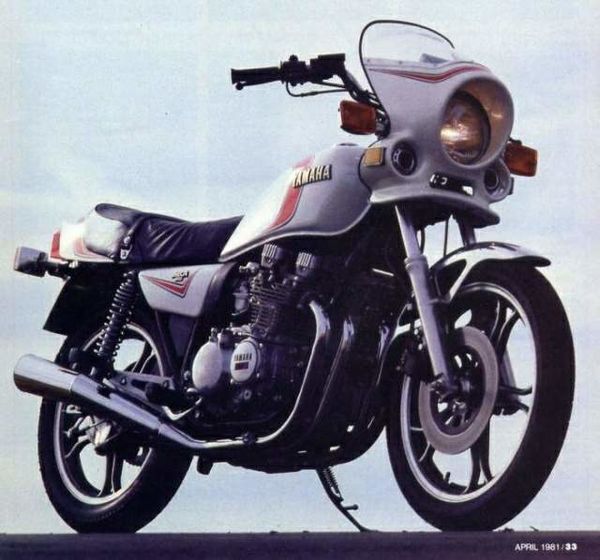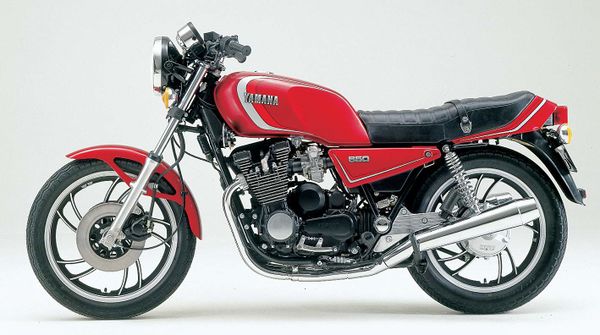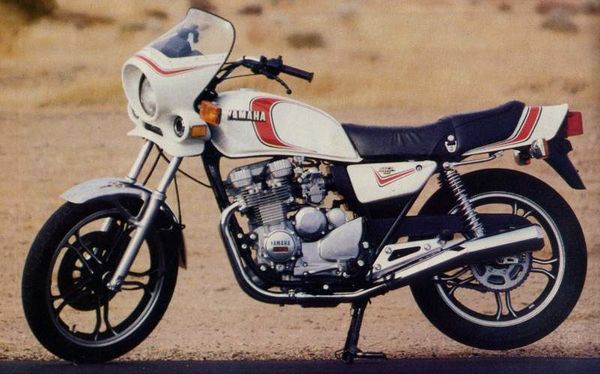Difference between revisions of "Yamaha XJ550 Seca"
(adding recommended_oil) |
(template fixes) |
||
| Line 1: | Line 1: | ||
{{Motorcycle | {{Motorcycle | ||
|name = | |name = Yamaha XJ550 Seca | ||
|photo=Yamaha-XJ550-Seca__1.jpg | |photo=Yamaha-XJ550-Seca__1.jpg | ||
|aka = | |aka = | ||
| Line 9: | Line 9: | ||
|predecessor = | |predecessor = | ||
|successor = | |successor = | ||
|class = | |class =Standard | ||
|engine = Four stroke, transverse four cylinder. DOHC, 2 valves per cylinder. | |engine = Four stroke, transverse four cylinder. DOHC, 2 valves per cylinder. | ||
|bore_stroke = | |bore_stroke = | ||
Latest revision as of 22:38, 23 November 2019
| File:Yamaha-XJ550-Seca 1.jpg | |
| Yamaha XJ550 Seca | |
| Manufacturer | |
|---|---|
| Production | 1981 |
| Class | Standard |
| Engine | Four stroke, transverse four cylinder. DOHC, 2 valves per cylinder. |
| Compression ratio | 9.5:1 |
| Top Speed | 178.6 km/h / 111 mph |
| Ignition | Battery powered inductive |
| Transmission | 6 Speed |
| Suspension | Front: Telescopic coil spring forks Rear: Swinging arm with dual dampers adjustable for preload |
| Brakes | Front: 2x 267mm discs Rear: 182mm Drum |
| Front Tire | 3.25-19 |
| Rear Tire | 110/ 90-16 |
| Weight | 205 kg / 450 lbs (wet) |
| Recommended Oil | Yamalube 10w-40 |
| Fuel Capacity | 15 liters / 3.9 US gal |
| Manuals | Service Manual |
It could reach a top speed of 178.6 km/h / 111 mph.
Engine[edit | edit source]
The engine was a Air cooled cooled Four stroke, transverse four cylinder. DOHC, 2 valves per cylinder.. The engine featured a 9.5:1 compression ratio.
Chassis[edit | edit source]
It came with a 3.25-19 front tire and a 110/ 90-16 rear tire. Stopping was achieved via 2x 267mm discs in the front and a 182mm Drum in the rear. The front suspension was a Telescopic coil spring forks while the rear was equipped with a Swinging arm with dual dampers adjustable for preload. The XJ550 Seca was fitted with a 15 liters / 3.9 US gal fuel tank.
Photos[edit | edit source]
Overview[edit | edit source]
Yamaha XJ 550R Seca
Labels arerelative.Though the Seca hasn't changed
mechanically, it's drifted from sport to mainstream in comparison, of course,
to the competition.
Superbikes with their claim to 11-second quarter-miles and outrageous top
speedsdominated the Seventies. In a similar way, middleweights are laying claim
to the Eighties. Capable of mid-twelves in the quarter, with agility unrivaled
by full-liter bikes and, maybe best of all, carrying price tags well below three
grand, the best of the 550s are attracting sport enthusiasts like never before.
Kawasaki opened up the '80s with the introduction of the KZ550faster than any
of the other middleweights except Yamaha's 650 Maxim.
The KZ's only class rivals (the Honda 550-turned-650 and the Suzuki 550) were mildewing with age, designed in the early- to mid-'70s with only minor subsequent updates. So along came 1981, and Yamaha sprang the Seca on us, which was competitive with Kawasaki's refined KZ and new GPz. But technology (thankfully) keeps blossoming: the GPz got better in 1982 while the Seca dropped back a notch. Still, the Yamaha ranked above the musty Honda and Suzuki middleweights. Nineteen-eighty-three and, oh what a difference a year makes! The Kawasaki GPz has been refined, Suzuki's 550 is all new (with racetrack-inspired styling and technology), and Honda's new Nighthawk 550 and 650 are fast, fast, fast. And the Yamaha Seca? It is, basically, an '81 bike with more sedate styling. Less its handlebar-mounted sport fairing and flashy red-on-white paint scheme, the new Seca comes only in black with red and purple stripes. Following an '82 change, the front fender and fork sliders are color-matched to the bodywork.
This latest Seca has more mainstream appeal, though its sporting potential is still commendable. Moreover, it remains the lightest and narrowest four-cylinder bike in its class. Mechanically, the Seca is unchanged from the original model. The narrow engine design, made possible by mounting the alternator on top of the transmission case, was an important step in creating a more compact, lighter motorcycle. Honda is just now using that design on the new Night-hawks. Narrow engine cases do more than just improve Ground Clearance; ergonomics improve as well. With a narrower engine, the footrests can move in closer to the fore-aft center line of the motorcycle.This enables the pegs to be mounted low, allowing a fairly expansive seating position while still maintaining good cornering clearance.
Though modern in design, the Seca's twin-valve double-overhead-cam engine lacks the development of other manufacturers' mid-sized fours. Quarter-mile performance strongly reflects an engine's output, and here the Seca falls behind. Its quarter-mile figures13.05 @ 98.46pale against those of the current 550 King, the GPz. Kawasaki's rocket will blast through the quarter in 12.7 seconds at 103 miles per hour, while offering the same versatile power as the Yamaha. The Seca uses a straightforward chassis design. With 27 degrees of rake, 4.29 inches of trail and a 55.5-inch wheelbase, the 550 promises a cross between agile and stable handling, and it makes good on that promise. The Seca staggers very little in crosswinds, and the bike does nothing to surprise the rider; it just plain works well. Though its suspension components lack air assists and adjustable damping, the Seca accommodates most riding styles and handles most conditions wellexactly as a mainstream motorcycle should. The Seca's seating position falls between traditional and sport. The handlebar's pullback invites an upright riding position, and, fortunately, the instrument nacelle is high enough to act as a decent windbreak; the traditional-style handlebar won't cause wind-related discomfort unless you regularly cruise at supra-legal speeds. The footpegs, mounted halfway between sport and traditional, complement the seat-bar position well. A comfortable seat allows easy cruising for an hour or all day; the short step leading to the passenger area is small enough to let tall solo riders scoot back easily. History seems to be repeating itself, with just a change in characters. A few years ago the Yamaha Seca was the fresh face in the crowd of middle-weights while the Honda and Suzuki were the tried-and-true standbys. For 1983 the roles are reversed: the Seca has established itself as a solid performer by providing good power and handling all around (but not the best in class), while the new bikes are waiting in the wings to prove themselves.
Source Cycle
| Make Model | Yamaha XJ 550R Sega |
|---|---|
| Year | 1981 |
| Engine Type | Four stroke, transverse four cylinder. DOHC, 2 valves per cylinder. |
| Displacement | 528 cc / 32.2 cu-in |
| Bore X Stroke | 57 X 51.8 mm |
| Cooling System | Air cooled |
| Compression | 9.5:1 |
| Induction | 4x 28mm Mikuni carburetors |
| Ignition | Battery powered inductive |
| Starting | Electric |
| Max Power | 37 kW / 50 PS @ 9000 rpm |
| Max Torque | 41.9 Nm / 4,3 m-kg @ 7500 rpm |
| Transmission | 6 Speed |
| Final Drive | Chain |
| Front Suspension | Telescopic coil spring forks |
| Front Wheel Travel | 137 mm / 5.3 in |
| Rear Suspension | Swinging arm with dual dampers adjustable for preload |
| Rear Wheel Travel | 80 mm / 3.7 in |
| Front Brakes | 2x 267mm discs |
| Rear Brakes | 182mm Drum |
| Front Tire | 3.25-19 |
| Rear Tire | 110/ 90-16 |
| Wet Weight | 205 kg / 450 lbs |
| Fuel Capacity | 15 liters / 3.9 US gal |
| Consumption Average | 55 mpg |
| Standing ¼ Mile | 13.4 sec / 98 mph |
| Top Speed | 178.6 km/h / 111 mph |


